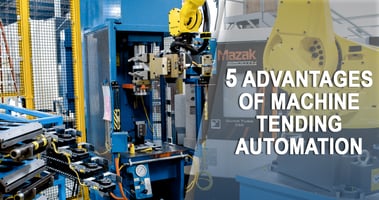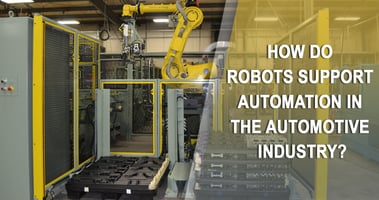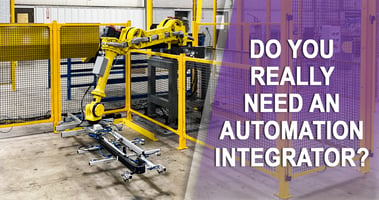Machine tending is often considered a highly complex process within manufacturing facilities....
Improving Quality and Profitability with Automated Material Handling
.jpg?width=1684&name=Blog%20Post%2015%20-%20Banner%20Photo%20-%20FINAL%20(1).jpg)
Material handling, as a manufacturing term, encompasses a wide range of processes. It touches everything from machine tending and packaging to machine tending, press tending, picking, packing and palletizing. It is essential to the world’s supply chain capabilities and, therefore, a prime opportunity for integrating automation. As global realities, competitive pressures and consumer demands continue to shape (and reshape) the manufacturing landscape, automated material handling solutions become smarter and more advantageous than ever.
While some businesses hesitate to make the initial investment in packaging automation machines and technology, the longer-term returns and rewards simply can’t be overlooked. Automation has permeated so many aspects of production operations over the years, and for substantial reasons. We’re providing a detailed look at these reasons so you can make a more informed decision about whether packaging automation is a worthwhile consideration for your business.
1. Minimizing Human-Made Errors
We’ve said it before and we’ll say it again: When you take steps to minimize the impact of error-prone humans within your processes, you decrease your risk of experiencing product damage. Particularly when it comes to functions for which human involvement provides no added value, automated material handling solutions can be a major advantage.
Simply put, automation has the distinct capability of lessening margins of error. Humans do not operate with the same level of precision and repeatability that machines do, so when it comes to highly repetitive tasks, such as many of those in the material handling category, integrating automation frees your processes from a number of the unnecessary mistakes and imperfections generated by the fallibility of humans.
2. Preserving Process-Intensive Applications
There are certain applications within the material handling realm that require absolute certainty with regard to performance. Without it, the quality of the product suffers. These types of applications are ones in which automated material handling solutions are integral.
One vivid example of this reality is the application of aluminum die casting. To ensure a quality product from this process, the die must remain at a very consistent temperature throughout. Therefore, it must be opened and closed in a very predictable fashion. If this does not happen with the requisite level of control and predictability, the temperature can fluctuate and impact the quality of the casting by introducing porosity.
The same concept can be applied to plastic injection molding, where heated oil runs through the molds to keep them at a pre-set temperature. If that temperature fluctuates, consistency of the part varies as well. Here, again, is an example of why the precision and predictability ensured through automation is vital to overall product quality.
3. Reducing Overall Waste
While we’re on the subject of human error and unpredictability, it’s important to discuss the related topic of scrap and waste. With damaged materials or products comes the profitability-paring expense of waste and disposal.
The less human touch involved in your material handling processes, the less risk of damage or defect, which translates to less overall scrap. There’s a real disservice done to your bottom line when producing products that do not meet specifications and are therefore not salable—a disservice that can be remedied, in many ways, with automated material handling.
4. Mitigating Safety Risks
With human error and limitations also comes the dangers of injury to workers. In material handling processes, there can be immense amounts of stress placed on the body from actions such as:
- Lifting, carrying or holding heavy or unbalanced materials
- Applying fast movements to lift or place materials
- Bending or twisting the back to pick up materials
In addition to these types of injuries, there is the inherent risk of trips and falls, as well as the danger of working in material handling environments that involve unfavorable conditions with regard to temperature, chemical exposure, close proximity to other humans and other factors. Automation enables you to mitigate these risks by alleviating the need for humans to be involved in those types of situations.
5. Cutting Labor Costs
Perhaps this is the most obvious way automated material handling helps improve profitability for a business, and that’s because the savings are significant.
Automation naturally minimizes the need for manpower, even while maximizing throughput. And, let’s face it, the cost of finding, compensating, insuring, retaining and then possibly replacing employees is not a small one. Especially in an industry where (and at a distinct time when) labor shortages are rampant, there’s a clear benefit to having minimal reliance on human interaction.
Successfully Integrating Material Handling Automation
While the potential benefits of integrating automation within material handling applications are relatively universal, the design and integration process is quite unique to your individual business. It’s important to understand that each factory’s needs, goals and future considerations will impact the type and extent of automation they can profitably apply.
The good news is that you don’t have to be an automation expert if you partner with an experienced, knowledgeable integrator that knows the right questions to ask in order to support you in making smart, scalable choices. A valuable professional integrator recommends the best automation solutions based on what you are making, for whom and what the future may look like. Keep this important reality in mind as you consider the prospect of automating your material handling functions and make a plan to move forward.



